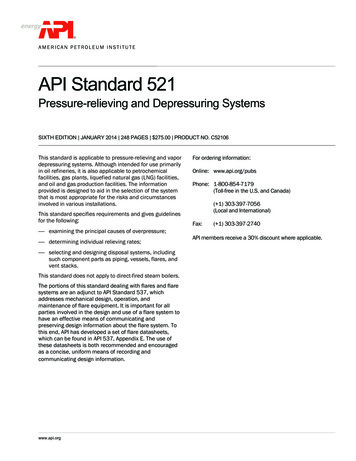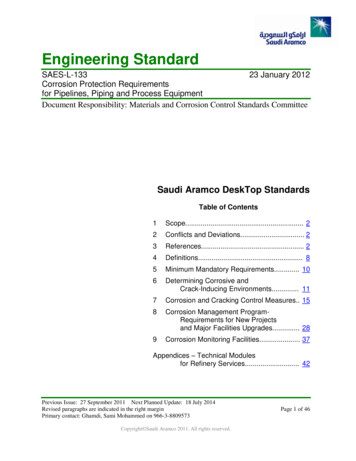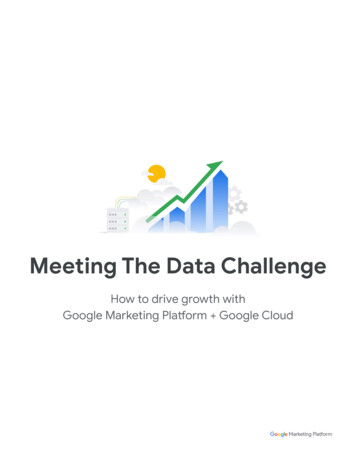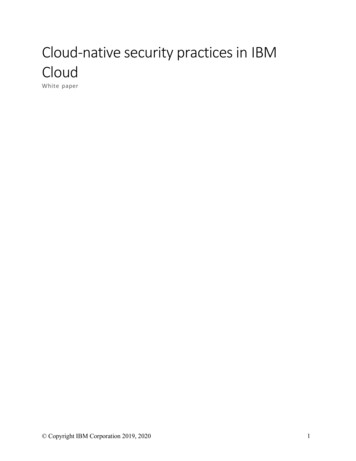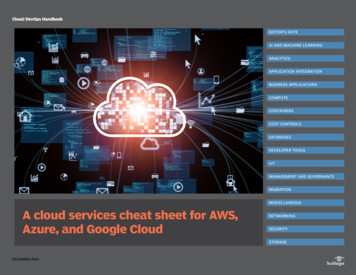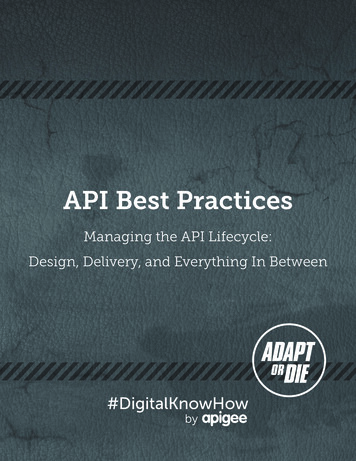
Transcription
API Best PracticesManaging the API Lifecycle:Design, Delivery, and Everything In Between
Table of ContentsExecutive Summary 04APIs in a Modern Software Development Context 05Enforce consistent security and governanceDrive end-to-end visibilityMake services easily discoverable and reusableCo-exist with microservices orchestration frameworkDon’t adopt cloud-specific gatewaysManaging the API Lifecycle 09API Design 10Adopt a layered API strategyDesign easy-to-consume APIsPick the right API versioning approachAPI Security 16Mitigate OWASP threatsPrevent volumetric attacksProtect against adaptive threatsDon’t rely on WAFs for API securityAPI Testing and Development 19Align the API lifecycle with the SDLCTest APIs using TDD and BDD approachesDeploy APIs depending on type of workloadAutomate your testing and development lifecycleDeveloper Portal 23Publish automated, interactive documentationPackage your APIs for consumptionAutomate developer onboardingTie user identities to existing enterprise IDMs CC BY-SAAPI Best Practices
API Analytics 26Optimize API functionality by tracing API callsMonitor peak performance and availabilityMeasure API program success with the right metricsEmpower App developers with usage and perfomance dataAPI Operations 31Deploy API management in the cloud or on-premisesIntegrate with existing monitoring infrastructureScale API platform infrastructureConclusion 36 CC BY-SAAPI Best Practices
Executive SummaryDigital is disrupting every industry. From drug store chains to banks to telcos, businesses arebecoming software companies and adopting modern software practices. Why? If they don’tadapt to a new market reality they will fail.As the business context is changing so is the technology stack. Enterprise applicationarchitectures are evolving from integration-centric enterprise service bus (ESB) architecturesto application-centric, microservices, platform-as-a-service (PaaS), multi-cloud, and API-drivenarchitectures.APIs are the lynchpin to the success of these digital businesses.All applications use APIs to access application services and data through APIs. These servicescan be microservices or cloud workloads or legacy SOAP services or IoT.To ensure that applications and developers can effectively use these services to build partner,consumer, and internal apps, companies need to deliver secure, scalable, easy-to-use modernAPIs.Over the last few years, we’ve participated in hundreds of enterprises’ API-led digitaltransformation initiatives. This guide distills our learnings from these customer engagementsand shares best practices about managing APIs across the lifecycle.Secure Transform PublishAnalyze Scale MonetizeCloud AppsPartner AppsConsumerAppsAPIsLegacy AppsEmployeeAppsInternetof Things CC BY-SAAPI Best Practices4
APIs in a Modern Software Development ContextGartner found that 77% of app development supporting digital business will occur in-house.Seventy percent of organizations claim to be either using or investigating microservices, andnearly one-third currently use them in production, according to a report from NGINX. Multicloud strategies will jump from just 10% in 2015 to more than 70% in three years, according toGartner.Why? Because microservices, cloud, and platform-as-a-service (PaaS) technologies enableorganizations to innovate fast: development teams can independently develop, deploy,and scale applications. The adoption of the cloud, containers, and continuous integration/continuous deployment (CI/CD) tools has made new apps implementation easier, leading tomore modern software being built as microservices in the cloud.Moreover, because different workloads have different needs that may be best delivered by aparticular cloud vendor (or with a private cloud deployment), organizations are adopting multicloud strategies. App development teams implement microservices using a variety of stackslike Kubernetes, Netflix OSS, and Mesos, depending on their needs. All these microservicesand cloud workloads use web APIs as the mechanism to communicate with one another.Public rviceµServiceµServiceAPIsApp WorkloadsMicroservicesPrivate CloudPrivate cloud CC BY-SAPlatform-as-a-ServiceAPI Best Practices5
APIs in a Modern Software Development ContextThere’s a challenging side effect, however. As app development teams rush to implementmicroservices across multiple clouds or in a PaaS, they inadvertently create silos withinconsistencies in security, visibility, documentation, and governance. For example, many APIsare not secured, or are secured inconsistently, across organizations.They might not be accompanied by standardized documentation, or access controlmechanisms. These microservices and cloud APIs are often difficult to reuse, analyze, or evento discover for use by other teams.How to:Eliminate silos created with inconsistencies in security,visibility, and discoverabilityEnforce consistent security and governanceIn the world of microservices and public clouds, there should be no distinction betweeninternal and external APIs.Developers are building APIs and microservices without the kind of centralized oversightthat once existed. They are deploying them more widely than ever before. They implementinconsistent and varying levels of security—or no security at all.When developers deploy microservices in the public cloud and neglect to deploy commonAPI security standards or consistent global policies, they expose the enterprise to potentialsecurity breaches. A microservice could be used by another app in the cloud today and by anexternal partner tomorrow.Companies must assume a zero-trust environment. An API platform enables enterprises toimplement security and governance policies like OAuth2 across all of their microservices APIs.Drive end-to-end visibilityWithout usage and performance data about your microservices and cloud workloads,it’s difficult to understand the extent to which these services are reused, or potentialperformance bottlenecks. The problem is more acute when these APIs are used by multipleteams in a large enterprise or as external APIs for partners and customers. CC BY-SAAPI Best Practices6
APIs in a Modern Software Development ContextAPI platforms provide fine-grained analytics and reporting capabilities to measure APIusage, developer and partner engagement, microservices adoption, and traffic composition.Organizations use API analytics to monitor API performance by analyzing total traffic,throughput, latency, and errors.Make services easily discoverable and reusableAs enterprises employ multiple and disparate microservices stacks, clouds, and PaaSenvironments, it can be difficult for teams to discover and reuse microservices and APIs.Internal and external app developers use developer portals to discover services, register touse APIs, access interactive and community documentation, register their apps, and view dataabout their app usage on a dashboard.Co-exist with microservices orchestration frameworksApp teams are adopting a variety of microservices orchestration tools including Kubernetes,Docker, and Mesos. Although there is some overlap in the gateway functionality betweenthe microservices stack and API management, most organizations colocate their APImanagement with their microservices and PaaS gateway/routers to ensure consistent visibilityand discoverability across the organization.MicroservicesStackAPI ManagementStackLoggingAuto-ScalingSpike ArrestCircuit BreakerTLS/SSLService DiscoveryLoad BalancingFederatedInfrastructure& DeploymentsCachingRoutingGatewayAPI ServicesManagement ServicesAnalyticsDev MgmtService DiscoveryCircuit BreakerMonitoring /Alerting CC BY-SAAPI Best Practices7
APIs in a Modern Software Development ContextDon’t adopt cloud-specific gatewaysAll public cloud providers offer their own captive API gateways (AWS API gateway, forexample) that provide basic functionality like traffic management, simple meditation, andcaching. For the needs of most enterprises, the functionality of these cloud-specific gatewaysis too limited; they don’t solve the problem of silos across the various clouds that manyorganizations employ.Companies like Autodesk have adopted an enterprise API platform to support its applicationworkloads, including serverless apps being built on AWS. Instead of using the AWS gateway,they realized the value of having a single pane of glass for all APIs across their organizations,regardless of which cloud these APIs might operate in.“A central unified API platform across the companyhas been a game changer for us.”- Alan Williams, Autodesk CC BY-SAAPI Best Practices8
Managing the API LifecycleAs organizations adopt modern software practices, holistic API management has becomecritical. Enterprises put in place people, processes, and technologies to manage APIs acrossthe entire API lifecycle—from design through to analysis and operation. By adopting bestpractices in each stage of the API lifecycle, teams become more agile and can deliver on thepromise of digital transformation.Different organizations have slightly different API lifecycles, but for simplicity’s sake we’reusing the API lifecycle below to share best practices.DESIGNOPERATESECUREANALYZEDEPLOYPUBLISH CC BY-SAAPI Best Practices9
API DesignA well-crafted API should make an app developer as successful as possible. When buildingAPIs, it’s critical to think about design choices from the app developer’s perspective.Why? Look at the value chain below. The app developer is the linchpin of the entire APIstrategy. The primary design principle when building an API should be to maximize appdeveloper productivity and success.Modern organizations use the API-first strategy, in which they start by documenting the APIusing the Open API specification before implementing code. Documenting and mocking theAPI straight away enables greater collaboration and accelerates overall software delivery.With the app developer in mind, there are several best practices to ensure agility and ease ofconsumption of APIs.How to:Design and build your APIs to ensure ease-ofconsumption and fast delivery for developersAdopt a layered API strategyOrganizations are embracing a layered API approach to make it easier for developers toconsume SOAP and other legacy services from systems of record. This approach enablesdevelopers to deliver new software faster across a plethora of mobile devices andform factors. CC BY-SAAPI Best Practices10
API DesignHighly consumable APIs,specific for set a ofdevices or apps/android/customerExperience APIsConsumable andreusable APIs–thecore set of developerfriendly APIs/customerBusiness APIsHighly reusableAPIs that mimicunderlying datamodels & resources/cms/catalogue/oms/itemExposure APIsCRMFinancialsInventoryHRSupply ChainIn a layered API approach, you have various flavors of APIs:Exposure APIs, which are RESTful, cached, secure modern APIs to your legacy SOAPservices (/crm/catalog , /cms/item, for example). These are tied closely to your backendsystems.Business or domain APIs, which are abstractions of business entities as consumableresources for app developers. An API-first design approach focuses on delivering theseconsumable resources and hides implementation details from developers by providing aconsistent interaction across disparate backends (/catalog, for example).Experience APIs are tightly coupled to a particular set of consuming applications/devices.Specializing to a particular UI, API developers provide an optimized experience to the appdeveloper focusing on things like aggregation and optimizing payload for performance(/android/catalog, for example).This layered API approach abstracts the underlying complexities and dependencies of APIsand systems below and accelerates delivery of new apps. Organizations use the concept ofproxy chaining (connecting one or more proxies to connect to a remote host) available in APImanagement platforms to build layered APIs. CC BY-SAAPI Best Practices11
API DesignDesign easy-to-consume APIsA good API design makes the API easy to consume by the app developer. Below are a set ofdesign best practices that have enabled many API designers with SOAP design experience tobuild the right set of easy-to-consume RESTful APIs.Using a data-centric modelAPIs should focus on the underlying entities/resources they expose, rather than a set offunctions that manipulate those entities. In other words, the URLs should have nouns, notverbs. For example, a collection of dogs could have a URL https://dogtracker.com/dogs. And,individual dogs would each have a unique URL like http://dogtracker.com/dogs/9876543. Withthis approach, you can retrieve the details of the dog using the GET method, delete the dogusing the DELETE method, and modify properties of the dog using the PATCH orPUT methods.By contrast, in a function-oriented API, there is much more variability, and much more detaila developer has to learn. And there is no clear structure or pattern you can use to help themwith the next API.Building simple JSONDue to its simplicity, JavaScript Object Notation (JSON) has become the de facto standardfor web APIs. When JSON is used well, it is simple and intuitive. If your JSON doesn’t look asstraightforward as the example below, you may be doing something wrong.{ “kind”: “Dog”“name”: “Lassie”,“furColor”: “brown”,.}Your JSON API will be simpler and easier to understand if you stick to the principle that thenames in your JSON are always property names, and the JSON objects always correspond toentities in your API’s data model. CC BY-SAAPI Best Practices12
API DesignExpressing relationships as linksIf your web APIs do not include links today, a first step is simply to add some links withoutmaking other changes, like this:{ “id”: “12345678”,“kind”: “Dog”“name”: “Lassie”,“furColor”: “brown”,“ownerID”: “98765432”,“ownerLink”: g links makes it easier for app developers to consume resources, with less to learn and noneed to hunt for documentation. Moreover, links can be plugged into templates to producethe right URL.Designing URLsA good way to make APIs human-friendly involves the creation of entity URLs that have theentity type in them when fetching a specific resource. Thus, instead of https://dogtracker.com/ZG9n;a8098c1a, it is more desirable to have https://dogtracker.com/dogs/a8098c1a.Also, it is not recommended to code a hierarchy of entities into an URL. Hierarchies are not asstable as they might seem; encoding them in your URLs could prevent you from reorganizingyour hierarchies in the future.For query URLs, it is recommended to use the gs rather than https://dogtracker.com/search?type Dog&owner {personId}Many app developer prefer the first format because it is more readable, more intuitive, andeasier for API developers to implement.Handling errorsA good error design is important for API designers, as it provides context and visibility intohow app developers use APIs. Developers learn to write code through errors and they dependon well-designed errors for troubleshooting, and resolving issues after the applicationsthey’ve built using your API are in the hands of their users. CC BY-SAAPI Best Practices13
API DesignThus, it is important to use standard HTTP status codes and complete HTTP responsemessages to communicate with app developers. For example, the 201 Created status codeshould always be paired with a Location header that provides the URL of thenewly-created resource.HTTP/1.1 201 CreatedLocation: https://dogtracker.com/dogs/1234567Use plain language in the payload messages, as there usually is a programmatic user agentbetween the user and the message.For further details on the above recommendations and many more best practices in APIDesign, refer to the eBook, Web API Design: The Missing Link.Pick the right API versioning approachLOWAPI TIER LOGICHIGHA common problem in managing APIs is versioning. When APIs are used by many developersand partners, getting everyone to upgrade to the latest API version is challenging, ifnot impossible.MediationRoutingRequests & responsesprocessed to deliver asexpected to bothbackend and clientsBackend versions aretransparent. Requestsrouted based on header,payload, user, etc.Error HandlingPass-ThroughReturns errorsgracefully for old APIversion requestsForwards all incomingrequests to the rightbackend versionSingle API VersionMultiple API VersionsBACKEND SUPPORTS CC BY-SAAPI Best Practices14
API DesignOrganizations take different approaches to versioning, depending on their willingness to addbusiness logic in the API tier and the limitations of maintaining multiple versions on backendsystems. On the northbound side, most organizations typically include version numbers in thebase path of the the API call (for example, api.company.com/v1/ , api.company.com/v2/ ).Error handlingIf the backend systems can support only one API version and an organization wants to limitbusiness logic in the API proxy layer, the API proxy can send an error for older versions. It canbe gradually phased out by adding an error message to inform the developer, followed by theaddition of strict rate limits on older API versions and, finally, blocking requests andsending errors.Pass-throughIf the backend supports multiple API versions, the API proxy layer can be kept lean and simplyenable the northbound requests to pass through to the right soundbound APIs. Organizationsuse analytics in API platforms to understand the usage of API versions, deprecate low-trafficversions, and communicate with targeted developers using older versions.RoutingMany organizations use an API platform to decouple the northbound and southbound APIsfor agility and maintenance purposes. In these cases, depending on the variety of parameterslike request path, query parameters, or payload, the API platform can route the request to theright backend versions based on business logic in the API proxy layer.MediationIf the backend system can’t support multiple API versions, organizations can add businesslogic in the API proxy layer to mediate the request/response of various northbound APIversions. The API platform will process the incoming requests and create a southboundrequest that’s supported by the backend. It does the same on the response by processing thebackend response and sending the response in the right format/data back to the client. Aslong as the mediation rules are relatively simple, this option is attractive.“An API-first vision and approach is what is needed to take advantage of social,mobile, analytics, and cloud. It’s the perfect storm for innovative CIOs.“- Brian Lillie, Equinix CC BY-SAAPI Best Practices15
API SecurityThree-quarters of mobile apps fail standard security tests—and most cyber attacks target theapp layer, according to Gartner.Organizations have used web application firewalls and DDoS (distributed denial of service)protection solutions to secure their web apps. However, in the world of mobile, cloud, andmicroservices, where enterprise data is accessed with APIs in a zero-trust environment, what’sneeded is security at all points of engagement. After all, hundreds of thousands of sensitivecustomer records or millions of dollars are at risk.There are known threats. The Open Web Application Security Project (OWASP), an onlinecommunity of application security researchers, publishes an annual list of the top 10 securitythreats enterprises face. But there are also potential attacks from “unknown” threats—software that constantly scans for vulnerabilities in application infrastructures.For protection against all kinds of external threats, organizations should create proxies infront of their APIs with an API management platform and enforce a set of consistent securitypolicies at the API proxy layer.How to:Enforce a consistent set of securitypolicies across all APIsMitigate OWASP threatsOWASP threats include XML/JSON injection threats, cross-site scripting attacks, brokenauthentication, insecure direct object reference, and several others. Seventy-two percent oforganizations using an API management platform employ out-of-the-box security policies toprotect their external-facing APIs from these threats.To prevent data leakage in transit, organizations also implement out-of-the-box OAuth2and two-way TLS on all critical APIs. Using OAuth2 with the right set of scopes ensuresminimization of the attack surface available for threats. Using a PCI- and HIPAA-compliantAPI platform, organizations can create secure proxies and ensure APIs keys are stored inencrypted mode. CC BY-SAAPI Best Practices16
API SecurityAPI MANAGEMENTData SecurityOrg BoundariesEncryptionSOC 2, PCI-DSS, mentand GovernanceRBAC ManagementIDM IntegrationGlobal PoliciesUser ProvisioningAD / LDAP GroupsAppsData SecurityTwo-Way TLSAPI KeyOAuth2BackendThreat ProtectionQuota/Spike ArrestSQL Threat ProtectionJSON Bomb ProtectionIP Based RestrictionsRegular Expression ValidationAccess ControlData SecurityOAuth2API Key VerficationIP Access ControlLogging & AuditingTwo-Way TLSSouthbound VPNIP Access ControlLogging & AuditingPrevent volumetric attacksApplication layer volumetric attacks comprise 17% of all reported DDoS attacks. In theseattacks, an application is flooded with HTTP requests, tying up application servers. Eightypercent of organizations use API management platforms with out-of-the-box spike arrest andrate limiting policies to mitigate risk from such attacks. Applying quota and rate limits to APIsprovides protection from sophisticated DDoS attacks that mimic human behavior.Protect against adaptive threatsUnlike web apps, APIs are programmable, making it easier for attackers to target APIs usingbots. Bot traffic can probe for weaknesses in APIs, abuse guest accounts with brute forceattacks, use customer API keys to access private APIs, abuse loyalty programs, or scrapepricing data for competitors via APIs. Bad bots comprise 10% to 15% of internet traffic today.An advanced API platform uses sophisticated machine learning algorithms on dataaggregated across multiple customers. Because it analyzes billions of API calls, it candistinguish legitimate human traffic more effectively than it would from a single data source.When the API platform identifies a bot-like signature in an call pattern, it flags that signature.An organization can then specify the action to take for each such identified bot signature.The API platform then automatically takes appropriate actions like blocking, throttling, orhoneypotting. CC BY-SAAPI Best Practices17
API SecurityDon’t rely on WAFs for API securityMany organizations use web application firewalls (WAF) to secure their web apps. But howdoes an API platform, with its API security capabilities, fit with WAFs?Typically, WAFs treat applications as black boxes and apply IP-based (or some light contentbased traffic blocking). However, API platforms have the ability to fully inspect API calls—and,as a consequence, can do a better job of API security than a WAF. API platforms are “smarter,”as they have an execution engine built right into the proxy layer. Data persistence in APIplatforms enables you to do more (stop bots, for example) than stateless operations.EDGEWAFEDGEEDGEWAFApplication /Microservice123In the potential options above, as the sophistication of API platforms continue, mostorganizations’ application security needs would be covered by API platforms (option 1 above).It has the benefit of lower overall latencies and consistent management of security policies.If your existing WAF is built into your CDN, option 2 might be the right approach. The APIplatform sits behind the WAF/CDN. In situations where applications can only be accessedthrough a WAF gateway, option 3 might the right approach.“We wanted to secure our APIs, as we don’t distinguish between internalor external use.”- Ole Dallerup, TrustPilot CC BY-SAAPI Best Practices18
API Testing and DeploymentOnce API proxies are designed and built, they need to be tested and deployed intoproduction. But these API proxies don’t live in isolation. They’re closely linked to the targetAPIs/backend applications they front. Thus, one needs to coordinate the API lifecycle and thesoftware development lifecycle (SDLC) of these applications.One of the critical phases of the API lifecycle is testing. Organizations have adopted testdriven development (TDD) and behavior-driven development (BDD) approaches to applicationtesting; they’re also using TDD and BDD to test their APIs. Organizations can also leveragetheir application testing framework and tools to automate API testing and reduce themaintenance costs of their API catalog.How to:Sync the API lifecycle with the SDLC and automatetesting and deployment of APIs.Align the API lifecycle with the SDLCEvery organization has its own SDLC with various stages (dev, test, and prod, for example).The API lifecycle should be aligned with the SDLC process.To ensure separation of concerns between production and non-production API usage,organizations use the concept of organization available in an API management platform tokeep users, APIs, and API traffic distinct from one another.API management platforms also employ the concept of environment, which providesthe runtime execution context for the API proxies (target endpoints, for example). It isrecommended to have two organizations (production and non-production) and six differentenvironments for your API proxies in an API platform as shown below. Typically, the pre andprod environments are setup in a production organization, while the rest of the environmentsare setup in a separate, non-production organization. CC BY-SAAPI Best Practices19
API Testing and DeploymentAPI LifecycleAPI LifecycleAPI LifecycleAPI TargetAPI TargetTargetTarget BackendApp SDLCBackendApp VIn the example above, if the target backend app has fewer stages, you can either reduce thenumber of API lifecycle stages/environments or point a number of different API environmentsto the same target environment (API PERF and API UAT point to APP PERF, for example).As the API proxy goes from one stage to another, different types of testing and targetbackends are used. An API lifecycle can be automated by employing the same continuousintegration (CI) framework and tools used for applications.Apart from the target app SDLC above, the apps consuming the APIs will have their own SDLCand the API lifecycle needs to be in-sync with that SDLC. Typically, there is also a sandboxenvironment provided for app developers to test their apps with a mock backend. After theinitial app development, developers typically use prod APIs for the rest of their SDLC.Test APIs using TDD and BDD approachesOrganizations use TDD or BDD approaches to create the right set of tests to validate the APIbeing built. In the dev environment, API proxies are created from Open API specifications;alternatively, template patterns are used to generate proxies with yeoman generators orcommon proxy templates. The API proxies are then attached a set of out-of-the-box policieslike XML/JSON threat protection or OAuth2. Most organizations store the API proxies in thesame repository as their application code (typically GitHub).Organizations do behavioral testing of their APIs in this stage, using mock targets to ensurewide testing coverage. Static code analysis can be run on custom policies (Java or JavaScriptpolicies) with tools like JSLint and CheckStyle, followed by unit testing and code coverage.Typically, organizations use tools like Junit and Mocha for unit testing and Istanbul andCobertura for code coverage.In the INTEGRATION (INTG) phase, the APIs use a real TEST target. You can use tools likeapickli for functional and integration testing. In the PERF stage, performance is tested usinga non-production southbound target to determine performance degradation and volumecapacity limits. CC BY-SAAPI Best Practices20
API Testing and DeploymentIn UAT, PRE and PROD, a smaller subset of tests are run to test basic API setup andfunctionality. The PRE environment is a mirror of prod and is used for final testing beforedeployment of production APIs. When moving an API proxy into production, an organizationshould also publish the specifications and associated documentation to the developer portal.Once an API proxy is ready for production deployment, an organization needs to decidewhere to deploy it.Deploy APIs depending on type of workloadThe target backends of API proxies can be microservices, legacy SOAP services, cloudworkloads, or services in a PaaS. Several attributes of the target application/servicedetermine where and how API proxies should be deployed. They include: Type of service Microservices or a serverless or monolith app Existing interface RESTful API or legacy API, such as a SOAP API Application environment On premises, in the public cloud, or in a PaaS Use case Internal consumption only or for external use (partners, for example)An organization can either deploy production proxies into a centralized runtime environmentor deploy proxies in a distributed mode.Centralized deploymentIn this mode, the API is deployed to a central set of gateways that are either hosted inthe public cloud or in an organization’s private data centers, depending on where the APImanagement solution is deployed. Typically, for external use cases or monolith apps runningin the public cloud, this is the preferred approach to minimize operational overhead. Forapplications with legacy interfaces that require complex transformations and processing,centralized API deployment may be the only option.Distributed deploymentFor internal use cases, microservices, or serverless apps, it’s best to have the API closer t
Developers are building APIs and microservices without the kind of centralized oversight that once existed. They are deploying them more widely than ever before. They implement inconsistent and varying levels of security—or no security at all. When developers deploy microservices in the public cloud and neglect to deploy common


